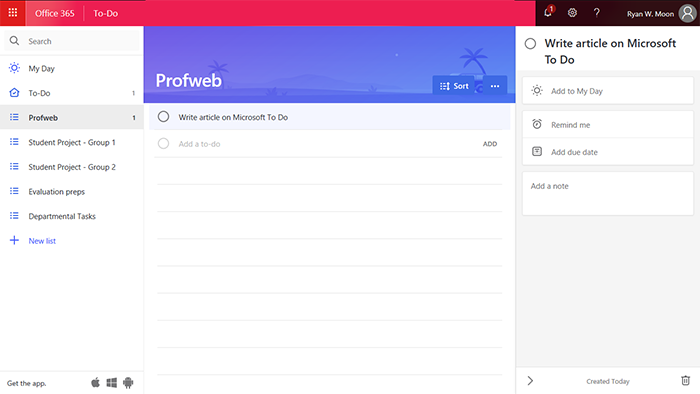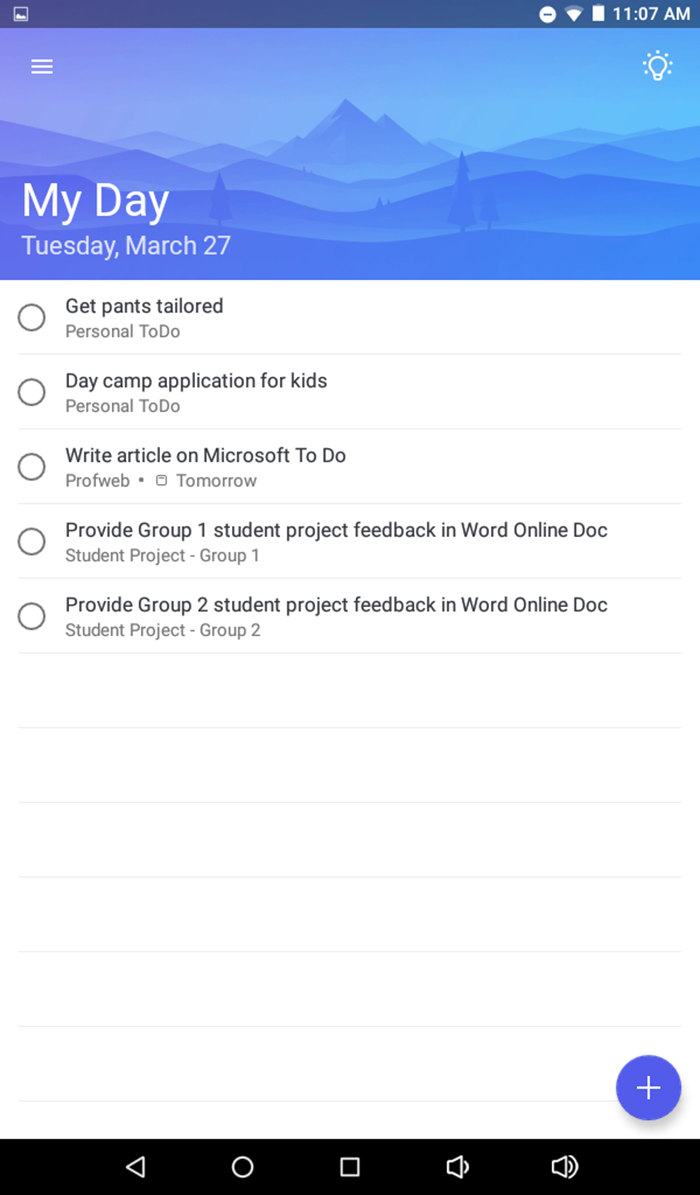Taming Pedagogical Prerogatives and Personal Projects with Microsoft To-Do
Do you find yourself bombarded with requests on a daily basis? Have you found a solution to keep track of it all and stay on top of these requests? While working within the Office 365 ecosystem I recently discovered Microsoft To-Do, a bare-bones, easy-to-learn and easy-to-use cloud-based task manager. The application syncs with your smartphone or tablet, so that you can immediately record requests from students, colleagues, family and friends.
Video introducing Microsoft To Do
Starting Microsoft To-Do
Microsoft To-Do is included in the Office 365 suite of applications, or can be downloaded for iOS, Android and mobile devices using Windows. Assuming that you are using the cloud-based version of Microsoft To-Do, you can simply login by visiting the Microsoft To-Do website, or by using the app launcher if you are already logged in to Microsoft Office 365.

The Office 365 app launcher
The Office 365 app launcher appears on the upper left-hand side of your browser window. By clicking the small squares, you are provided with a list of apps. To find Microsoft To-Do, click on the “All apps” link.

A view of the cloud-based version of Microsoft To-Do within the Office 365 environment.
Setting Up Lists
On your first visit to Microsoft To-Do, you will be presented with the “My Day” and “To Do” default lists. The “To Do” list automatically imports tasks from Microsoft Outlook. This is already very handy for managing work-related tasks. We’ll get to the “My Day” list in a moment.
There are essentially 2 elements that you will work with in Microsoft To-Do: the list and the “to-do.”
Lists are a way for you to categorize the “to-do” tasks by theme. In the screenshot above, I have created a list called Profweb, by clicking on the “New list” link. Once the new list is created, you will have the opportunity to add tasks by clicking on the “Add a to-do” link. You can add as many “to-do” items as required. You can set due dates for each item by right clicking on the title of the “to-do,” but your options are limited to “today” and “tomorrow.” If your list of “to-do” items is long, you can sort alphabetically, by due-date or by the date that the item was created. Both lists and “to-do” items can be dragged and dropped by order of importance, if desired.
In very little time you will be able to record all of your tasks, leaving you more time to actually do the tasks! Taking a page from Pavlov’s playbook, Microsoft has included a rewarding bell sound each time you click in the little blank circle to mark one of your to-do tasks as complete.
Prioritizing with Intelligent Suggestions for “My Day”

A view of the Microsoft To-Do app on an Android tablet showing “My Day.”
In Microsoft To-Do, there is a dashboard view called “My Day” which helps you to prioritize items for your day. You have the option to manually decide which “to-do” items from the various lists will make it into your day by right clicking on the task’s title and clicking on “Add to my day.” However, there is an interesting feature known as intelligent suggestions that offers potential tasks to add to your day. These can be accessed by clicking on the light bulb icon in Microsoft To-Do.
Microsoft To-Do’s intelligent suggestion lightbulb. Intelligent suggestions provides you with a list of potential tasks that you can pick and choose to add to your daily dashboard of “to-dos.”
Potential Applications in an Educational Environment
Microsoft To-Do is potentially useful for a wide variety of educational stakeholders for simple prioritization and recording of tasks, but for teachers there may be some specific areas where it can provide useful:
- Organize tasks to prepare in-class activities (ex. Booking a room and equipment, preparing for a simulation)
- Group-specific follow-up for team projects (ex. group-specific checklists to provide individualized support during the development of their project)
- Creating a task to add a potential improvements to the class plan while an activity is actually taking place
- Preparation and follow-up for departmental meetings
Students can also be encouraged to use their college Office 365 accounts to create their own lists in To-Do in order to help them with their time and task management.
Like many of the Office 365 applications, Microsoft To-Do is likely to evolve over time. I hope we will see some “to-do” sharing and collaborative features in the future. This would really unlock the potential for group-work applications and sharing or delegating tasks.
Give it a Go!
In the short time that I have used Microsoft To-Do I have already found it very useful for taming my daily onslaught of personal and professional tasks! Little by little, the dozens of sticky notes I use on a weekly basis will find their way into my mobile device. I love that that I can now pull the smartphone out of my pocket and instantly add items to my to-do list and have them synchronize with my desktop environment. So when a colleague asks me a favour, a manager intercepts me in the hallway with a high-priority task, or I get the inevitable call from home to pick up some grocery items on the way home, I’ll always be on task!

